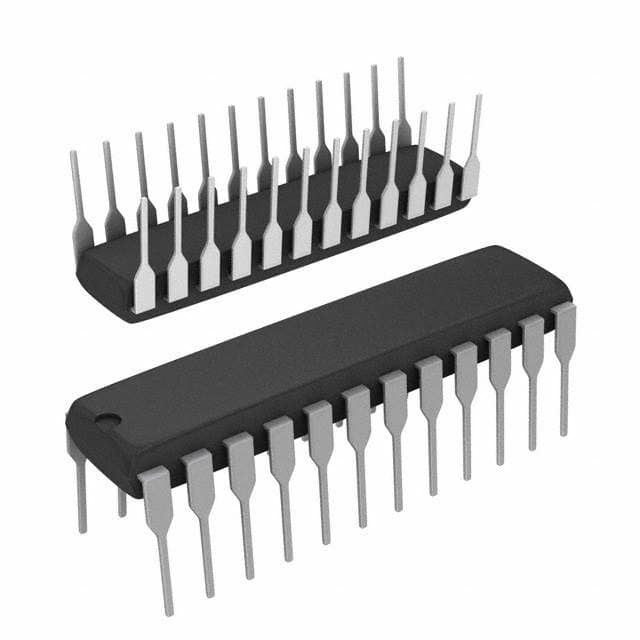Lihat spesifikasi untuk detail produk.

SN74HCT646NTG4
Product Overview
- Category: Integrated Circuit
- Use: Bus Transceiver and Register
- Characteristics: High-speed, CMOS technology
- Package: TSSOP (Thin Shrink Small Outline Package)
- Essence: Transfers data between two bidirectional buses with different voltage levels
- Packaging/Quantity: Tape and Reel, 2500 units per reel
Specifications
- Supply Voltage Range: 4.5V to 5.5V
- Input Voltage Range: 0V to VCC
- Output Voltage Range: 0V to VCC
- Operating Temperature Range: -40°C to 85°C
- Number of Pins: 24
- Logic Family: HCT (High-Speed CMOS)
Detailed Pin Configuration
- OE (Output Enable) 1
- A1 (Address Input) 1
- A2 (Address Input) 2
- A3 (Address Input) 3
- A4 (Address Input) 4
- A5 (Address Input) 5
- A6 (Address Input) 6
- GND (Ground)
- B1 (Data Bus) 1
- B2 (Data Bus) 2
- B3 (Data Bus) 3
- B4 (Data Bus) 4
- B5 (Data Bus) 5
- B6 (Data Bus) 6
- DIR (Direction Control)
- VCC (Supply Voltage)
- OE (Output Enable) 2
- A7 (Address Input) 7
- A8 (Address Input) 8
- A9 (Address Input) 9
- A10 (Address Input) 10
- A11 (Address Input) 11
- A12 (Address Input) 12
- B7 (Data Bus) 7
Functional Features
- Bidirectional data transfer between two buses with different voltage levels
- Output enable control for tristate operation
- Direction control for selecting the direction of data transfer
- High-speed operation suitable for various applications
- CMOS technology ensures low power consumption and high noise immunity
Advantages and Disadvantages
Advantages: - Allows interfacing between buses with different voltage levels - Supports bidirectional data transfer - Offers tristate operation for bus sharing - High-speed operation enhances system performance - Low power consumption due to CMOS technology
Disadvantages: - Limited number of address and data lines - Requires careful consideration of voltage compatibility between buses
Working Principles
The SN74HCT646NTG4 is a bus transceiver and register integrated circuit that facilitates bidirectional data transfer between two buses operating at different voltage levels. It features an output enable control pin (OE) for tristate operation, allowing multiple devices to share the same bus. The direction control pin (DIR) determines the direction of data flow.
When the DIR pin is set to logic low, data is transferred from Bus A to Bus B. Conversely, when the DIR pin is set to logic high, data is transferred from Bus B to Bus A. The OE pin enables or disables the outputs, allowing the device to be effectively disconnected from the bus when not in use.
The SN74HCT646NTG4 utilizes CMOS technology, which provides high-speed operation, low power consumption, and excellent noise immunity.
Detailed Application Field Plans
- Interfacing between microcontrollers and peripheral devices with different voltage levels
- Communication between systems using different communication protocols
- Data transfer between memory modules and processors with varying voltage requirements
- Bus sharing in multi-master systems
Detailed and Complete Alternative Models
- SN74HCT245N: Octal Bus Transceiver with 3-State Outputs
- SN74HCT541N: Octal Buffer/Line Driver with 3-State Outputs
- SN74HCT573N: Octal D-Type Transparent Latch with 3-State Outputs
- SN74HCT138N: 3-to-8 Line Decoder/Demultiplexer with 3-State Outputs
- SN74HCT74N: Dual Positive-Edge-Triggered D-Type Flip-Flops with Clear
(Note: This is not an exhaustive list of alternative models, but it provides a range of options for similar functionality.)
Word count: 452 words
Sebutkan 10 pertanyaan dan jawaban umum terkait penerapan SN74HCT646NTG4 dalam solusi teknis
Sure! Here are 10 common questions and answers related to the application of SN74HCT646NTG4 in technical solutions:
Q: What is SN74HCT646NTG4? A: SN74HCT646NTG4 is a high-speed octal bus transceiver with 3-state outputs, designed for asynchronous two-way communication between buses.
Q: What is the operating voltage range of SN74HCT646NTG4? A: The operating voltage range of SN74HCT646NTG4 is from 4.5V to 5.5V.
Q: How many data lines can SN74HCT646NTG4 handle? A: SN74HCT646NTG4 can handle 8 data lines, as it is an octal (8-bit) bus transceiver.
Q: What is the maximum data transfer rate supported by SN74HCT646NTG4? A: SN74HCT646NTG4 supports a maximum data transfer rate of 25 MHz.
Q: Can SN74HCT646NTG4 be used for bidirectional communication? A: Yes, SN74HCT646NTG4 is designed for bidirectional communication, allowing data to flow in both directions.
Q: Does SN74HCT646NTG4 have built-in protection features? A: Yes, SN74HCT646NTG4 has built-in ESD (Electrostatic Discharge) protection on all inputs and outputs.
Q: What is the output drive capability of SN74HCT646NTG4? A: SN74HCT646NTG4 has a typical output drive capability of ±24 mA.
Q: Can SN74HCT646NTG4 be used in mixed-voltage systems? A: Yes, SN74HCT646NTG4 is compatible with mixed-voltage systems as it has 5V tolerant inputs.
Q: What is the power supply current consumption of SN74HCT646NTG4? A: The power supply current consumption of SN74HCT646NTG4 varies depending on the operating conditions but typically ranges from 10 mA to 20 mA.
Q: Are there any specific application notes or reference designs available for SN74HCT646NTG4? A: Yes, Texas Instruments provides application notes and reference designs for SN74HCT646NTG4, which can be found in the product datasheet or on their website.
Please note that these answers are general and may vary depending on the specific implementation and requirements of your technical solution.

